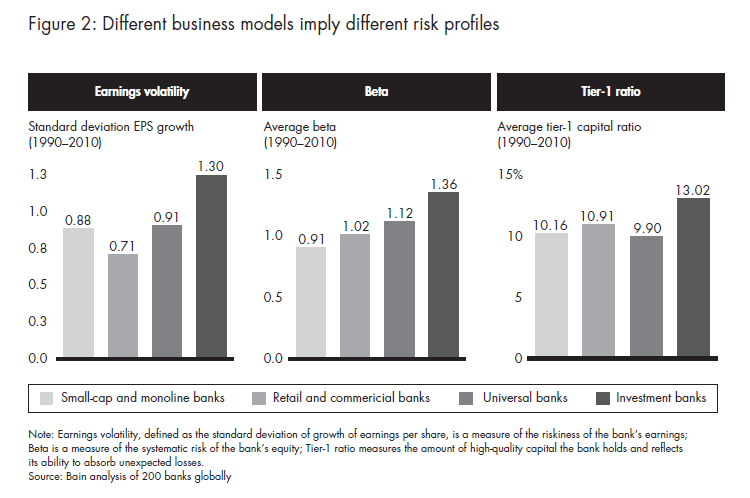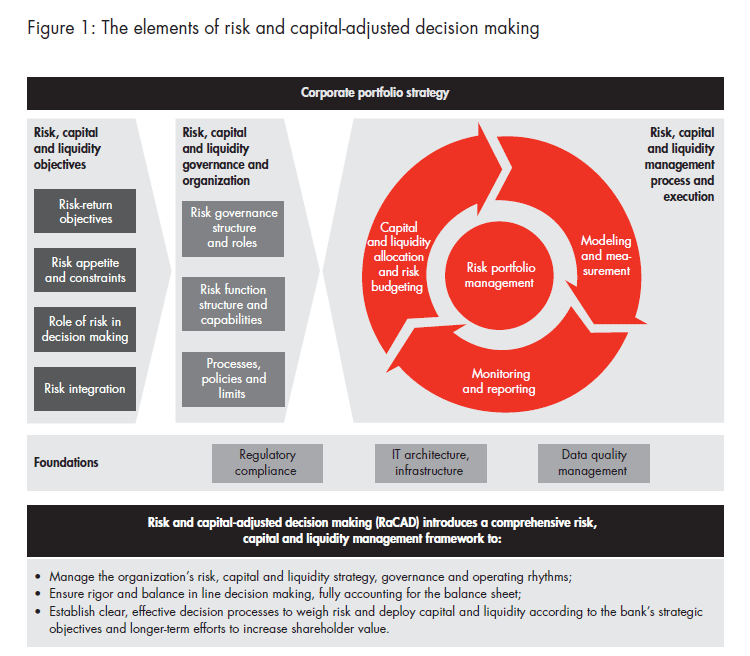Brief
Banks have traveled a hard road since the global financial crash of 2008. They have had to weave their way through the wreckage of bad debt, volatile funding markets and an uncertain economic environment. Now, tough new rules under Basel III and a host of local regulations will require banks to significantly increase capital and adhere to stringent new liquidity and funding mandates.
Meeting the new standards will put a big dent in banks’ return on equity and make it much harder for them to exceed their cost of capital. As banks begin to come to grips with these new realities, it is clear that many have been using an incomplete map to guide their business. The pursuit of revenue and earnings growth with insufficient attention to the balance sheet ran them into a ditch.
A comprehensive analysis by Bain & Company of approximately 200 banks around the world and interviews with more than 50 senior executives at more than 30 global institutions reveal how banks are modifying a broad range of practices they relied on before the crisis in order to better compete in the new environment. During the pre-crisis years of benign credit conditions and readily available liquidity, the disciplines of managing the balance sheet atrophied, becoming the almost exclusive preserve at many institutions of a small team of highly-skilled technocrats working from corporate headquarters. Leading banks now recognize that the ability to fully account for risk, capital and liquidity in line decisions will be a source of competitive advantage.
As they come to terms with how to strengthen balance sheet disciplines, bankers need to recognize the common set of challenges they face and the range of practices available to address them. In our executive surveys, we have found large differences in the understanding of risk, capital and liquidity and their implications on the balance sheet, both across business units and especially between the group-level functional specialists, on the one hand, and frontline commercial managers, on the other.
This gulf reflects deeply ingrained habits and incentives that will be difficult to uproot. Distracted by the quarterly earnings drumbeat, senior group leaders and line executives often have had little motivation to think like balance sheet custodians. Because the organization’s reward systems are often aligned to the profit-and- loss statement, critical qualities of business judgment can be missing. Lacking incentives to focus on risk- and capital-adjusted results, commercial managers either pay token heed to capital deployment, or they rely on the metrics that “black box” models generate without fully understanding what they mean.
To successfully navigate the difficult journey ahead, industry leading banks are implanting better balance sheet management capabilities throughout the organization—and particularly within their general management ranks. They recognize that there are no technical shortcuts. While strong, supporting technical expertise is necessary, it is not sufficient. If board members, senior executives and line managers do not anchor their business decisions in a risk- and capital-adjusted mindset, even the best technology does not count for much. An effective approach to managing through the balance sheet requires putting risk and capital at the heart of the bank’s strategy, the objectives that management sets, how the organization is governed, and how the business is run and monitored on a daily basis.
In our interviews, senior bank executives told us they were wrestling with how best to forge this joined-up view of the business. Many spoke of the need to invest more board-level time and attention into defining the enterprise’s overall risk appetite as the critical starting point for setting its portfolio and corporate strategy. Others told us that they are redefining managerial roles and putting in place processes, policies and limits to give risk, capital and liquidity a central role in their bank’s planning cycle. They described steps they were taking to shore up the structures, risk modeling and measurements, information technology and compliance capabilities that are the underpinnings of the bank’s core budgeting and management functions.
Taken together, the comments we heard from bankers across the industry suggest that views are coalescing around new ways to think about running the bank with greater heed to the consequences of decisions on the balance sheet. They are best captured in common disciplines that form the connective tissue for a top-to-bottom system of risk and capital-adjusted decision making (RaCADTM) (see Figure 1). This approach links the bank’s overall strategy into concrete objectives, governance and processes for managing risk, capital and liquidity at the level of each of its businesses, linked to the day-to- day decisions taken by operating managers.
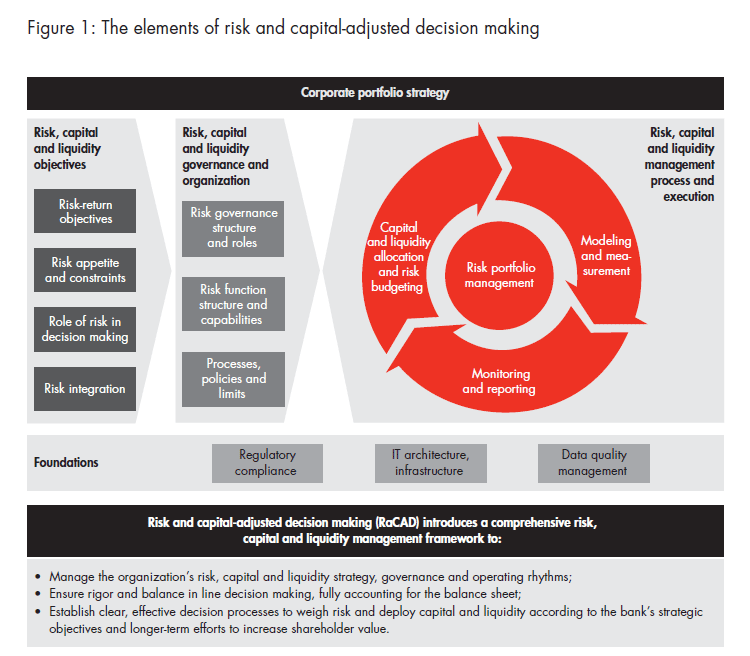
The new orientation marks a welcome shift in bankers’ strategic mindset from a drive to maximize short-term return on equity to a commitment to create sustainable, more valuable institutions. Among its chief virtues, it addresses two glaring vulnerabilities laid bare during the credit meltdown. First, it helps guide how banks construct their business portfolios with recognition that they may encounter rare, but potentially ruinous, “black swan” risks. Second, it instills a continuous managerial rhythm that quickens the entire organization’s reflexes to mitigate risks when market conditions deteriorate.
Although every bank needs to refocus on making the balance sheet the responsibility of managers from the top of the organization to the front lines, banks’ different business models present distinct risk profiles that call for different choices for how to do this (see Figure 2). For example, an investment bank pursuing an aggressive strategy to optimize its risks and returns may face volatile earnings swings over time. It will need sophisticated early-warning systems that are sensitive enough to alert them to shifting market risks and enable them to rapidly redeploy capital and provide liquidity across product lines. At the other end of the risk-return continuum, a regional retail bank that focuses on taking deposits and issuing loans may take a more conservative, lower-risk approach to managing its balance sheet. It may need to review capital allocation only once or twice a year. A universal bank may fall somewhere in between. It will need to manage risk in a way that accommodates the distinctive needs of its varied business lines while maintaining consistency and coherence across the group.
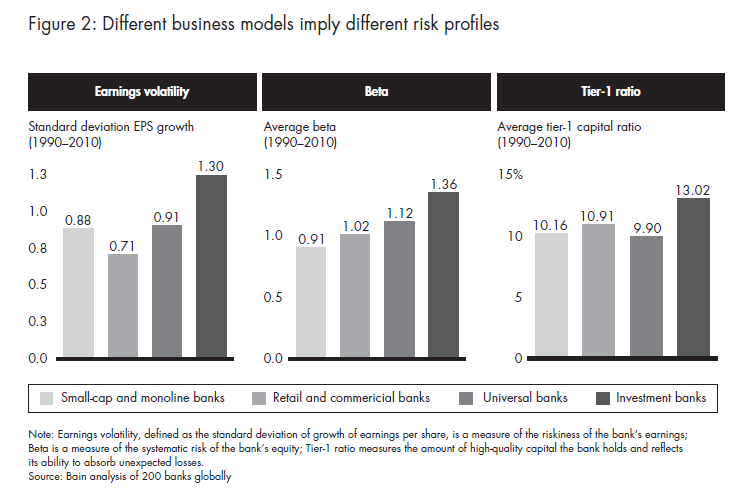
Irrespective of its business model or whether it operates in mature markets or emerging ones, nearly every bank we evaluated is rethinking how to ensure that its risk and capital management capabilities are robust enough to withstand today’s market volatility and positioned to adapt to the rapid changes sweeping the industry. None were convinced that they were there yet. But as they wrestle with how best to respond, bankers told us time and again that they were struggling to reconcile four fundamental dilemmas that the global financial crisis and regulatory environment have thrust into sharper focus. Let’s examine each and see how leading banks are beginning to tackle them:
1. Setting the “right” level of capital
Banks need to manage their balance sheet based on their strategy, risk appetite and business model. The choice of what level of capital to hold sends an important signal to shareholders, debt holders, regulators and politicians. But it also requires banks to weigh difficult trade-offs. Holding more capital can signal a bank’s commitment to stability and strength, but that makes it harder to generate superior returns. Taking a more aggressive approach in order to drive up returns, however, implies that the bank is willing to pin its prospects on a thinner cushion of capital.
Bank leaders recognize that more capital is required, of course, but the critical point of debate—one that will be ongoing for years to come—is how much more.
The discussion going around boardroom tables today is often taking a more nuanced view of the level of capital that is consistent with the bank’s risk appetite and commercial objectives than occurred pre-crisis. Directors and senior executives are now weighing three views of required capital, each of which reflects a distinct dimension of the bank’s freedom to maneuver in the marketplace while ensuring soundness and safety. Regulatory capital is the minimum amount of capital required by the regulator. Economic capital is the level of capital required to cover the bank’s risks as estimated by statistical modeling given numerous assumptions. Target capital—the ultimate choice—is the level of risk-adjusted capital the bank chooses to hold in order to maintain market, regulatory and political confidence in the institution’s ability to withstand stress robustly and maintain flexibility to be able to pay dividends over time. Typically defined as a percentage of risk-weighted assets, target capital is often used to calibrate economic capital models.
Leading banks set target capital with reference to key internal inputs, including their group strategy, their risk appetite, what their analytical models reveal about risk and return characteristics, and stress tests that show the impact of a variety of scenarios on the bank’s capital level. They also weigh external factors, including what regulators and ratings agencies require, what investors and clients expect and how the bank stacks up relative to its direct competitors (see Figure 3). These deliberations have led many to increase significantly both the actual level of capital they hold as well as the level they are targeting. Over the past three years, the 20 largest European banks have lifted their Tier-1 capital ratios by more than five percentage points to 13 percent through mid-2011.
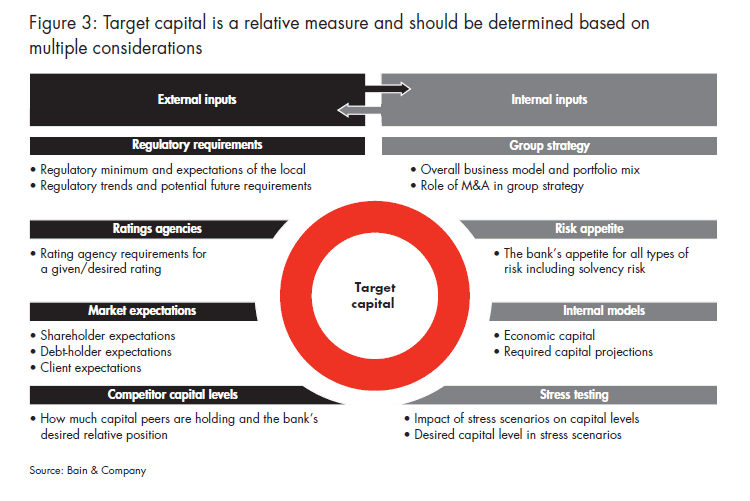
Once the bank has settled on the target capital level, it needs to communicate its rationale clearly, and often, to all stakeholders. Internally, it needs to determine whether all target capital should be allocated to businesses or some should be held in reserve at the center. Business unit managers need to understand how the amount of capital they are allocated reflects the risk of their business and why it may be more than either the bank’s regulatory minimum or the amount of economic capital they were allocated previously. Shareholders, debt holders and regulators need to be able to size up the amount of capital the bank is targeting, how this compares to the minimum and how much capital is currently available on the balance sheet. The differences between one and the other help investors gauge the bank’s risk profile, as reflected, for example, by its earnings volatility and its risk appetite.
The ultimate decision about how much target capital to hold comes down to a judgment call. It must accommodate the new expectations of shareholders, debt holders and regulators, on the one hand, and on the other, ensure that the business units to whom capital is allocated remain competitive.
2. Using the best metrics to support decision making
Banks have often gauged their performance primarily through the lens of return on equity (ROE), a single, inflexible, but easily understood yardstick. But its suitability as the primary measure of profitability has come under increased scrutiny in recent years. As a single-period measure, ROE falls short as a reliable indicator of returns across the ups and downs of the business cycle. Now with banks around the world needing to account for differences between regulatory and economic capital, many are understandably considering which other measures are the most appropriate basis for making decisions.
Leading banks are responding by applying a suite of metrics to get a 360-degree view of the impact of competitive challenges on their balance sheet. Some executives we spoke to told us that, in the wake of the financial meltdown and facing big capital increases mandated under Basel III, their banks have been inclined to back away from the use of economic capital as a measure to guide capital budgeting and allocation decisions. They are reverting instead to risk-weighted assets (RWA), a less nuanced and much simpler measure. But as the metric that best captures how much capital is needed to support commercial planning and pricing decisions at the granular level of customer segments, products or accounts, economic capital remains an indispensable tool for most. It enables operating managers to compare the return on risk-adjusted equity for competing investments, alternative ways to grow a new business—or decide when to withdraw from an existing one. It lets them know whether the opportunity they are weighing will produce returns that are higher or lower than shareholders require.
The choice of a predominant measure of capital that best suits a bank’s needs depends on the type of bank it is and its risk-return objectives. For example, a European bank that has historically managed based on its measurement of RWA is planning to shift its focus to monitoring economic capital in order to optimize capital deployment. By contrast, an Asian bank is moving to recalibrate its traditional economic capital model to match its definition of target capital to ensure that the sum of the capital allocated to its business units’ capital equals the whole at the group level. In a third case, a global investment bank is de-emphasizing economic capital and will instead use regulatory RWA to measure and manage performance. This bank has a large trading business and views RWA as a better tool to guide a reduction in leverage, since the level of RWA has become its binding constraint.
Many of the bankers we spoke to reported that their banks are deploying both economic and regulatory capital systematically across their businesses. They report that economic capital often becomes the basis for determining how to allocate regulatory capital (the real constraint) with finer attention to product and customer segment.
As an antidote to the short-term thinking that plagued the industry pre-crisis, banks are also integrating stress tests into their capital measurement, allocation and planning processes. Most banks still run stress tests as a separate exercise, but a few—particularly investment banks and universal banks with exposure to significant market risks—are beginning to use them as an important tool for how capital is deployed. As an input to their capital allocation decisions, for example, they are requiring business units to develop forecasts that factor in stress, rather than consider it as a cursory check after the fact.
Banks should use multiple measures to gauge risk, guide capital allocation and ensure that they are creating real long-term value. Strategic decisions need to be informed by longer-term metrics than annual ROE and explicitly account for the volatility of each business unit’s returns under stress.
3. Making decisions that account for risk when competitors do not always do the same
Disciplines that put risk at the center of a bank’s decision-making process support better decisions. But if its rivals are not following a similar approach, the bank, after fully accounting for the costs of risk and capital, faces real commercial pressures to chase business that could result in its losing money or sacrificing hard-earned market share.
Banks need to move away from thinking that is fixated on gaining market share, increasing revenues or building volume. A more nuanced definition of growth objectives in the new environment concentrates instead on achieving sustainable competitive advantage and increasing the share of economic profits they capture over time in the markets where they compete. The leaders focus on embedding metrics, tools and decision-making criteria up and down the organization to achieve that end.
Many banks—including some that had the underlying information and tools but abandoned them in their pursuit of volume and share growth—are discovering that their organizations need to relearn these disciplines. As an executive at a global investment bank put it, “We had the most sophisticated capital modeling and tools in the industry, but during [the previous CEO’s] tenure it was all about league tables credits so no one paid much attention to economic capital. Then [a new CEO] came in and suddenly the water-cooler chat was about risk-adjusted return on capital. The measurements changed and so did the incentives.”
A risk and capital-adjusted perspective always needs to have a place at the executive table when making important decisions—even if decision-makers decide not to slavishly adhere to it. Even with the right risk-adjusted measures in place, bankers need to exercise judgment and draw on their experience to challenge how the balance sheet is being used, and interpret the bank’s commercial and competitive options.
Perhaps most important to their long-term success, leading banks have developed the ability to make explicit risk-return trade-offs at the business, segment, product and even transaction level in the face of changing market conditions. They hold line managers at the level of their individual businesses accountable for the P&L and the balance sheet, with high guardrails in place to ensure they stay on track. They equip them with robust management information and decision-support systems to help them understand, in real time, the impact of a dynamic market environment on their business-unit balance sheets.
Employing more sophisticated measures of risk capital gives bankers a better view of relative risk-adjusted profitability, which in turn surfaces both opportunities and challenges depending upon how competitors behave in the marketplace. To determine whether to accept a competitive challenge that is uneconomic in the short run, facts need to be combined with management’s judgment to determine whether the bank can earn an appropriate risk- and capitaladjusted return in a market, customer segment, product niche or area of expertise.
The choice of whether to accept a lower return on risk in order to remain competitive is a strategic judgment. Banks need to ensure that management is fully informed and aware of the potential consequences of their decisions. Maintaining discipline and transparency through the cycle is difficult but critical.
4. Deciding how best to invest in capital management capabilities
Banks are feeling heat from regulators, shareholders and market analysts to embed risk-adjusted decision making and culture across the organization. But doing so takes resources, time and energy that compete with other critical near-term priorities.
Under pressure to reduce costs, banks’ spending to train line managers in the lost art of balance sheet management and to erect a decision-making infrastructure around risk deep within the organization is apt to fall victim to budget cuts. That would be short-sighted.
Most banks we surveyed are continuing to invest to shore up their technical risk-management capabilities. Often, they are revising economic capital models and consolidating management information systems to make reporting more responsive to real-time needs. Many are also investing to strengthen the linkages between their risk appetite and strategy and to ensure that their taste for risk cascades down to the business units.
While these investments in technical expertise are necessary, they are insufficient by themselves. Banks also need to implant awareness of risk, capital and liquidity disciplines deep within their businesses. Unless the role of risk and capital figures prominently in decision making at every level, banks’ focus on bolstering technical capabilities risks repeating the mistakes of the past and potentially sowing the seeds of the next crisis.
Nearly all of the senior bank executives we interviewed mentioned how important their people and culture were to their success. But only a few forward-thinking banks truly engage line managers to better understand the interactions between the balance sheet and their commercial goals and behaviors. These banks are reinforcing those essential capabilities through communication and training and by sharpening the effectiveness of their decision making. “We want our wholesale-banking management team to think about capital as an input to the planning process, not just as a consequence,” a senior executive told Bain in an interview.
Banks need to make it a priority to invest in building understanding, capabilities and culture across their business leaders to ensure that they account for risk and capital in the decisions they make.
How to make risk and capital-adjusted decision making work for your bank
Clearly, banks that embrace this new way of thinking about and taking action to manage risk and capital face major cultural and behavioral challenges. For some, it means rediscovering disciplines that were lost in the heady days of the past decade. For others, it requires learning from new beginnings. How any individual bank tackles its capital management challenges depends on its specific business model, its strategic objectives and its unique starting point. Just as critical is how to sustain these new disciplines once they have been developed. As they take on the challenge of tailoring their new approach to risk and capital to their distinct purposes, bank leaders need to ask three questions:
First, what is the “right” risk and capital management model for us? The answer requires the bank to characterize its current business model, clarify its ambitions for where it wants to be, identify gaps it needs to close and judge what it takes to achieve its objectives.
Second, how effective and competitive are our current risk and capital management model and capabilities? To answer this question, management should assess whether its risk and capital objectives are clearly defined and understood, and judge whether risk, capital and liquidity are consistently embedded in decision making.
Finally, how should we prioritize and sequence changes in context of the external environment and our own starting point? To answer this, the bank needs to consider both the need for change—distinguishing between actions that are important from those that are urgent— and the bank’s capacity to deliver change by mobilizing leaders, modifying behaviors and enhancing capabilities.
Mike Baxter is a partner with Bain & Company and is based in the firm’s New York office. Thomas Olsen is a Bain partner based in São Paulo. Mark Judah is a principal based in Bain’s Sydney office. All are affiliated with the firm’s Financial Services practice.
Seven lessons for implementing a successful capital management framework
As banks refresh their approaches to capital management, they need to focus on some well-known, but often underappreciated, lessons for effective implementation.
- Lead change from the top. One of the reasons most cited by executives for failure was insufficient effort by senior management to take charge and lead the change process.
- Engage the businesses from Day One. Ivory-tower solutions do not work and are readily dismissed by the intended commercial users.
- Make risk, capital and liquidity management part of a coherent framework. Too often commercial managers view these initiatives as measures to limit and constrain them.
- Link adherence to risk-adjusted measures to executive pay and incentives. Banks cannot expect managers to think and act appropriately about risk, capital and liquidity until they correct the mismatch between what they do and what their compensation and incentives encourage them to do.
- Embed risk, capital (and liquidity) considerations in your core management processes. The bank’s approach to risk, capital and liquidity management should be tightly linked to strategy, planning and performance management.
- Find the right balance between technical accuracy and managerial clarity. Banks’ overreliance on complex models to calculate risks with pinpoint precision runs counter to their objective of providing frontline managers with clear guidance that will enable them to bring a risk mindset to bear in their businesses.
- Communicate, communicate. Continuous communications and training are essential.
